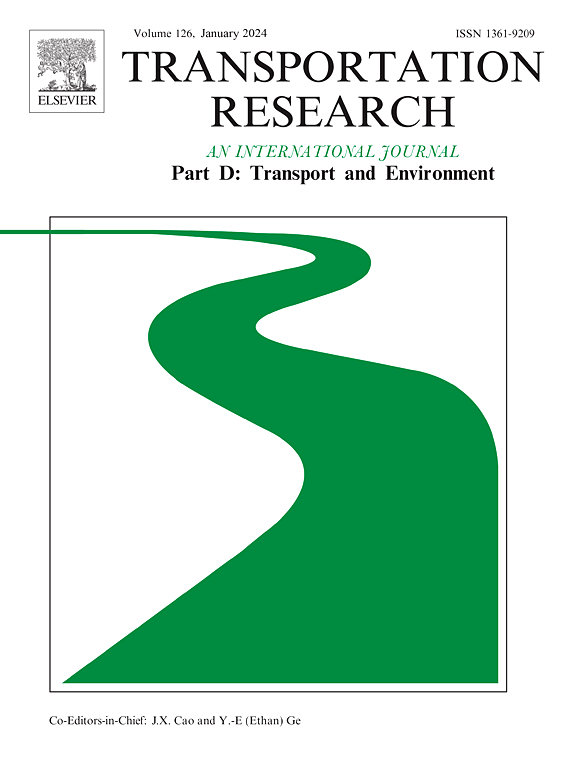Representative driving cycle-based framework to model indirect CO2 emissions from electric cars
IF 7.3
1区 工程技术
Q1 ENVIRONMENTAL STUDIES
Transportation Research Part D-transport and Environment
Pub Date : 2025-05-03
DOI:10.1016/j.trd.2025.104777
引用次数: 0
Abstract
Electric vehicle (EV) emission studies often rely on standard driving cycles and homogeneous grid compositions, neglecting regional variations. This study assesses EV well-to-wheel (WTW) emissions using a clustering-based optimized driving cycle model. Scenario-based WTW framework analyzes the emission impact of EV penetration, grid decarbonization, and internal combustion engine vehicle (ICEV) retirement policies at state and national levels through 2030. Tailored driving cycle estimates EV energy consumption (0.144 kWh/km) and emission factor (213 g CO2/km) using powertrain simulations, 45 % and 69.41 % higher than traditional cycle evaluations, respectively. 30 % EV penetration and accelerated grid decarbonization could potentially reduce sales emissions by 26.35 % (Telangana) and 33.98 % (India), though raise stock emissions. Early ICEV retirement would potentially reduce stock emissions by 20.54 % (Telangana) and 28.69 % (India). Vehicle kilometer traveled is identified as a crucial parameter impacting emissions. Transport decarbonization requires faster electrification, cleaner grid, early ICEV retirements, reduced travel demand, and enhanced battery efficiency.

基于驾驶循环的代表性框架,模拟电动汽车的间接二氧化碳排放
电动汽车(EV)排放研究通常依赖于标准的驾驶循环和均匀的网格组成,而忽略了区域差异。本研究使用基于聚类的优化驾驶循环模型来评估电动汽车井到车轮(WTW)的排放。基于场景的WTW框架分析了到2030年电动汽车普及率、电网脱碳以及州和国家层面内燃机汽车(ICEV)退役政策对排放的影响。根据动力系统模拟,定制驾驶循环估算出的电动汽车能耗(0.144千瓦时/公里)和排放系数(213克二氧化碳/公里)分别比传统循环评估高45%和69.41%。30%的电动汽车普及率和加速电网脱碳可能会使销售排放量减少26.35%(特伦甘纳邦)和33.98%(印度),尽管会增加库存排放量。提前淘汰电动汽车可能会减少20.54%(特伦加纳邦)和28.69%(印度)的排放。车辆行驶公里数被确定为影响排放的关键参数。交通脱碳需要更快的电气化、更清洁的电网、尽早淘汰电动汽车、减少出行需求和提高电池效率。
本文章由计算机程序翻译,如有差异,请以英文原文为准。
求助全文
约1分钟内获得全文
求助全文
来源期刊
CiteScore
14.40
自引率
9.20%
发文量
314
审稿时长
39 days
期刊介绍:
Transportation Research Part D: Transport and Environment focuses on original research exploring the environmental impacts of transportation, policy responses to these impacts, and their implications for transportation system design, planning, and management. The journal comprehensively covers the interaction between transportation and the environment, ranging from local effects on specific geographical areas to global implications such as natural resource depletion and atmospheric pollution.
We welcome research papers across all transportation modes, including maritime, air, and land transportation, assessing their environmental impacts broadly. Papers addressing both mobile aspects and transportation infrastructure are considered. The journal prioritizes empirical findings and policy responses of regulatory, planning, technical, or fiscal nature. Articles are policy-driven, accessible, and applicable to readers from diverse disciplines, emphasizing relevance and practicality. We encourage interdisciplinary submissions and welcome contributions from economically developing and advanced countries alike, reflecting our international orientation.

 求助内容:
求助内容: 应助结果提醒方式:
应助结果提醒方式:


